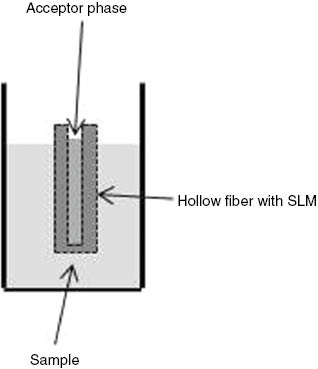https://doi.org/10.1351/goldbook.10280
Liquid-phase microextraction of analytes from a liquid (or gaseous) sample by a supported liquid membrane in the form of a porous hollow fibre with solvent-filled pores. The analytes are transferred to an acceptor phase contained in the cavity of the hollow fibre.
Notes:
- A typical experimental arrangement is shown in the figure below.
- The supported liquid membrane is generally an organic solvent immiscible with water and the sample an aqueous solution.
- The acceptor phase can be aqueous, which provides a three-phase extraction system (\(\ce{aqueous\!->\!organic\!->\!aqueous}\)), or an organic solvent, providing a two-phase extraction system (\(\ce{aqueous\!->\!organic}\)).
- The sample is agitated or stirred during extraction.

Typical experimental arrangement for hollow-fiber supported liquid membrane (SLM) for liquid-phase microextraction.
Source:
PAC, 2016, 88, 517. 'Glossary of terms used in extraction (IUPAC Recommendations 2016)' on page 549 (https://doi.org/10.1515/pac-2015-0903)
PAC, 2016, 88, 517. 'Glossary of terms used in extraction (IUPAC Recommendations 2016)' on page 549 (https://doi.org/10.1515/pac-2015-0903)